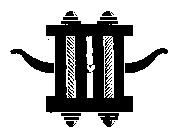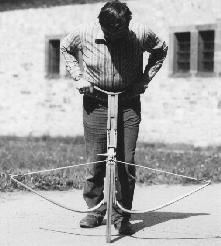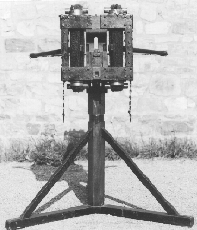 CATAPULTS IN GREEK AND ROMAN ANTIQUITY
CATAPULTS IN GREEK AND ROMAN ANTIQUITY
GASTRAPHETES
- the first ancient mechanical weapon

The gastraphetes (`belly-bow´)
was invented about 400 BC.
The weapon was cocked by resting
the stomach in a concavity at the rear of the stock and pressing down with
all strength. In this way considerably more energy can be summoned up than
by using only one arm of the archer as in the hand-bow.
There are no archaeological finds
known so far, but there is a detailed description preserved in Heron, Belopoica
together
with an accompanying text figure.
The reconstruction by E. Schramm
displayed here is mistakenly equipped with a steel bow. As Marsden 1969,
8-9 has shown, the ancient gastraphetes was powered by a composite bow.
EUTHYTONON - two-armed
torsion catapult, light arrow-shooter

The euthytonon was invented in
mid-fourth century BC. The weapon is powered by two torsion spings consisting
of rope bundles. On each end of a torsion spring there is a bronze washer
(modiolus) holding an iron lever (epizygis).
The two torsion springs and the four modioli are clearly visible in the
reconstruction displayed here, also the two arms of the weapon coming out
at the sides.
This light torsion catapult was
the most common type of artillery during the Hellenistic period. With only
slight modifications the weapon was employed still in the Early Roman Imperial
period, up to ca. AD 100, when the Romans redesigned their artillery.
Reconstruction by E. Schramm after
the Ampurias find (reconstruction displayed in: Saalburgmuseum, Bad Homburg,
Germany). For construction plan and description of Ampurias catapult see:
Schramm 1918, 40-46 pl.11.

Arrow-shooting catapult being cocked
by a windlass.
More reconstructions
Bibliography
Back
© D. Baatz, D-64297 Darmstadt,
Germany
Vers. 3 Febrary, 2001

 CATAPULTS IN GREEK AND ROMAN ANTIQUITY
CATAPULTS IN GREEK AND ROMAN ANTIQUITY

